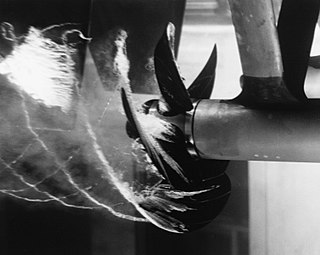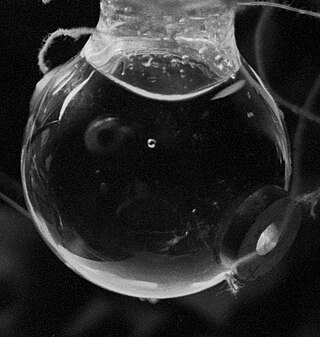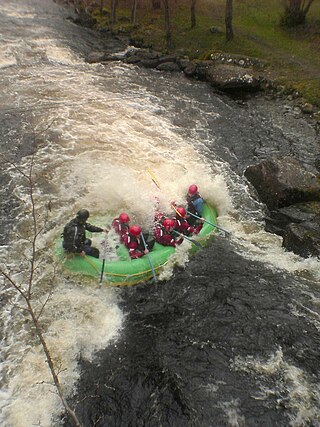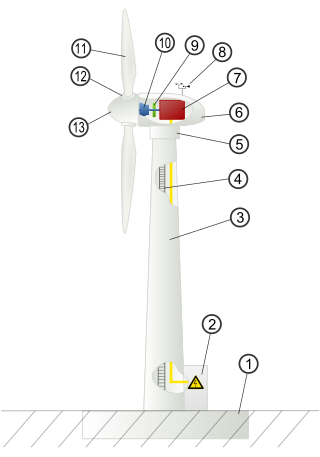
Water droplet erosion (WDE) is "a form of materials wear that is caused by the impact of liquid droplets with sufficiently high speed." [1] The phenomenon was furthermore previously known as liquid impingement erosion (LIE).

Water droplet erosion (WDE) is "a form of materials wear that is caused by the impact of liquid droplets with sufficiently high speed." [1] The phenomenon was furthermore previously known as liquid impingement erosion (LIE).
The emphasis of discrete water droplets serves to distinguish the WDE problem from liquid jet erosion and cavitation. The impact pressures invoked by discrete water droplet impact have a range considerably higher than the stagnation pressure created by liquid jet.
The difference between WDE and cavitation erosion is the fact that WDE usually comprises a gaseous or vaporous phase containing discrete liquid droplets; while cavitation erosion is observed when a continual liquid phase carries separate gaseous bubbles or cavities inside it. [2]
Recently, Ibrahim & Medraj developed an analytical model to predict the threshold speed of water droplet erosion and verified it experimentally, a challenge having been attempted hitherto without success since the 1950s. [3]

For an extended period of time, many industries have encountered the problem of erosion due to water droplet impact, and it continues to reappear wherever rotation or movement of a component at high speed in a hydrometer environment is employed. Recently, with the use of larger wind turbine blades, the issue of erosion of the leading edge due to rain droplets has grown more grave. Aerodynamics efficiency of turbine blades is severely diminished due to leading-edge erosion, resulting in a considerable decrease in annual energy production. [4]

Cavitation is a phenomenon in which the static pressure of a liquid reduces to below the liquid's vapour pressure, leading to the formation of small vapor-filled cavities in the liquid. When subjected to higher pressure, these cavities, called "bubbles" or "voids", collapse and can generate shock waves that may damage machinery. These shock waves are strong when they are very close to the imploded bubble, but rapidly weaken as they propagate away from the implosion. Cavitation is a significant cause of wear in some engineering contexts. Collapsing voids that implode near to a metal surface cause cyclic stress through repeated implosion. This results in surface fatigue of the metal, causing a type of wear also called "cavitation". The most common examples of this kind of wear are to pump impellers, and bends where a sudden change in the direction of liquid occurs. Cavitation is usually divided into two classes of behavior: inertial cavitation and non-inertial cavitation.

A turbine is a rotary mechanical device that extracts energy from a fluid flow and converts it into useful work. The work produced can be used for generating electrical power when combined with a generator. A turbine is a turbomachine with at least one moving part called a rotor assembly, which is a shaft or drum with blades attached. Moving fluid acts on the blades so that they move and impart rotational energy to the rotor. Early turbine examples are windmills and waterwheels.

A water turbine is a rotary machine that converts kinetic energy and potential energy of water into mechanical work.

Sonoluminescence is the emission of light from imploding bubbles in a liquid when excited by sound.

A hydraulic jump is a phenomenon in the science of hydraulics which is frequently observed in open channel flow such as rivers and spillways. When liquid at high velocity discharges into a zone of lower velocity, a rather abrupt rise occurs in the liquid surface. The rapidly flowing liquid is abruptly slowed and increases in height, converting some of the flow's initial kinetic energy into an increase in potential energy, with some energy irreversibly lost through turbulence to heat. In an open channel flow, this manifests as the fast flow rapidly slowing and piling up on top of itself similar to how a shockwave forms.

Wear is the damaging, gradual removal or deformation of material at solid surfaces. Causes of wear can be mechanical or chemical. The study of wear and related processes is referred to as tribology.

In industrial process engineering, mixing is a unit operation that involves manipulation of a heterogeneous physical system with the intent to make it more homogeneous. Familiar examples include pumping of the water in a swimming pool to homogenize the water temperature, and the stirring of pancake batter to eliminate lumps (deagglomeration).

In fluid mechanics, two-phase flow is a flow of gas and liquid — a particular example of multiphase flow. Two-phase flow can occur in various forms, such as flows transitioning from pure liquid to vapor as a result of external heating, separated flows, and dispersed two-phase flows where one phase is present in the form of particles, droplets, or bubbles in a continuous carrier phase.
A lie is a type of deception, an untruth or not telling the truth.

In fluid mechanics, a splash is a sudden disturbance to the otherwise quiescent free surface of a liquid. The disturbance is typically caused by a solid object suddenly hitting the surface, although splashes can occur in which moving liquid supplies the energy. This use of the word is onomatopoeic; in the past, the term "plash" has also been used.
The name electrospray is used for an apparatus that employs electricity to disperse a liquid or for the fine aerosol resulting from this process. High voltage is applied to a liquid supplied through an emitter. Ideally the liquid reaching the emitter tip forms a Taylor cone, which emits a liquid jet through its apex. Varicose waves on the surface of the jet lead to the formation of small and highly charged liquid droplets, which are radially dispersed due to Coulomb repulsion.

Sea spray are aerosol particles formed from the ocean, mostly by ejection into Earth's atmosphere by bursting bubbles at the air-sea interface. Sea spray contains both organic matter and inorganic salts that form sea salt aerosol (SSA). SSA has the ability to form cloud condensation nuclei (CCN) and remove anthropogenic aerosol pollutants from the atmosphere. Coarse sea spray has also been found to inhibit the development of lightning in storm clouds.

Thermal spraying techniques are coating processes in which melted materials are sprayed onto a surface. The "feedstock" is heated by electrical or chemical means.

Abrasion is a process of erosion which occurs when material being transported wears away at a surface over time. It is the process of friction caused by scuffing, scratching, wearing down, marring, and rubbing away of materials. The intensity of abrasion depends on the hardness, concentration, velocity and mass of the moving particles. Abrasion generally occurs in four ways: glaciation slowly grinds rocks picked up by ice against rock surfaces; solid objects transported in river channels make abrasive surface contact with the bed and walls; objects transported in waves breaking on coastlines; and by wind transporting sand or small stones against surface rocks.

Wind turbine design is the process of defining the form and configuration of a wind turbine to extract energy from the wind. An installation consists of the systems needed to capture the wind's energy, point the turbine into the wind, convert mechanical rotation into electrical power, and other systems to start, stop, and control the turbine.

A jet is a stream of fluid that is projected into a surrounding medium, usually from some kind of a nozzle, aperture or orifice. Jets can travel long distances without dissipating.
Erosion corrosion is a degradation of material surface due to mechanical action, often by impinging liquid, abrasion by a slurry, particles suspended in fast flowing liquid or gas, bubbles or droplets, cavitation, etc. The mechanism can be described as follows:

In fluid dynamics, drop impact occurs when a drop of liquid strikes a solid or liquid surface. The resulting outcome depends on the properties of the drop, the surface, and the surrounding fluid, which is most commonly a gas.

Gautam Biswas is presently a professor of mechanical engineering at the Indian Institute of Technology (IIT) Kanpur. Earlier, he has been the director of Indian Institute of Technology Guwahati, and director of the CSIR - Central Mechanical Engineering Research Institute at Durgapur. As a faculty member of IIT Kanpur, he has served the Institute in various capacities including the Dean of Academic Affairs. Prof Gautam Biswas is a Fellow of the three science academies, such as, the Indian National Science Academy, the Indian Academy of Sciences and the National Academy of Sciences India. He is a Fellow of the Indian National Academy of Engineering (INAE) and Institution of Engineers (IEI). He was the occupant of the position of GD and VM Mehta Endowed Chair Professor of Mechanical Engineering at the Indian Institute of Technology Kanpur. A Fellow of the American Society of Mechanical Engineers (ASME), Prof Biswas is the author of more than 150 scientific publications and guided 23 PhD theses. In the year 2011, he was awarded the esteemed J C Bose National Fellowship by the Science and Engineering Research Board (DST), Government of India. Biswas completed his B.E. from IIEST(Erstwhile B.E. College under Calcutta University) in 1979. He completed his PhD from the Indian Institute of Technology Kharagpur in 1985. He was an Alexander von Humboldt Fellow at the Ruhr University Bochum in Germany and JSPS Invitation Fellow at the Yokohama National University, Japan. He has been a guest professor at the Friedrich-Alexander-Universität Erlangen-Nürnberg, Germany. Prof. Biswas was awarded an honorary doctorate by the National Institute of Technology Agartala in 2017. He has been conferred honorary doctorate by the Aristotle University of Thessaloniki, Greece, in 2018. In recognition of his stellar contribution in the fields of Fluid Mechanics and Thermal Sciences, his contributions as an academic administrator and his dedicated service to the institute, IIT Kanpur bestowed upon Professor Gautam Biswas the award of Institute Fellow for the year 2020. In recognition of his outstanding contribution to teaching, IIT Kanpur conferred the Distinguished Teacher Award upon Professor Gautam Biswas in the year 2022. Prof. Biswas has been selected for 2023 ASME Heat Transfer Memorial Award in the Science Category for Sustained and Outstanding Contributions to Thermal Science and Engineering, including Heat Transfer Enhancement, Phase Change Heat Transfer with and without Electrohydrodynamic Forces and Dynamics of Liquid Jet and Droplet Impingement.

Joseph Katz is an Israel-born American fluid dynamicist, known for his work on experimental fluid mechanics, cavitation phenomena and multiphase flow, turbulence, turbomachinery flows and oceanography flows, flow-induced vibrations and noise, and development of optical flow diagnostics techniques, including Particle Image Velocimetry (PIV) and Holographic Particle Image Velocimetry (HPIV). As of 2005, he is the William F. Ward Sr. Distinguished Professor at the Department of Mechanical Engineering of the Whiting School of Engineering at the Johns Hopkins University.